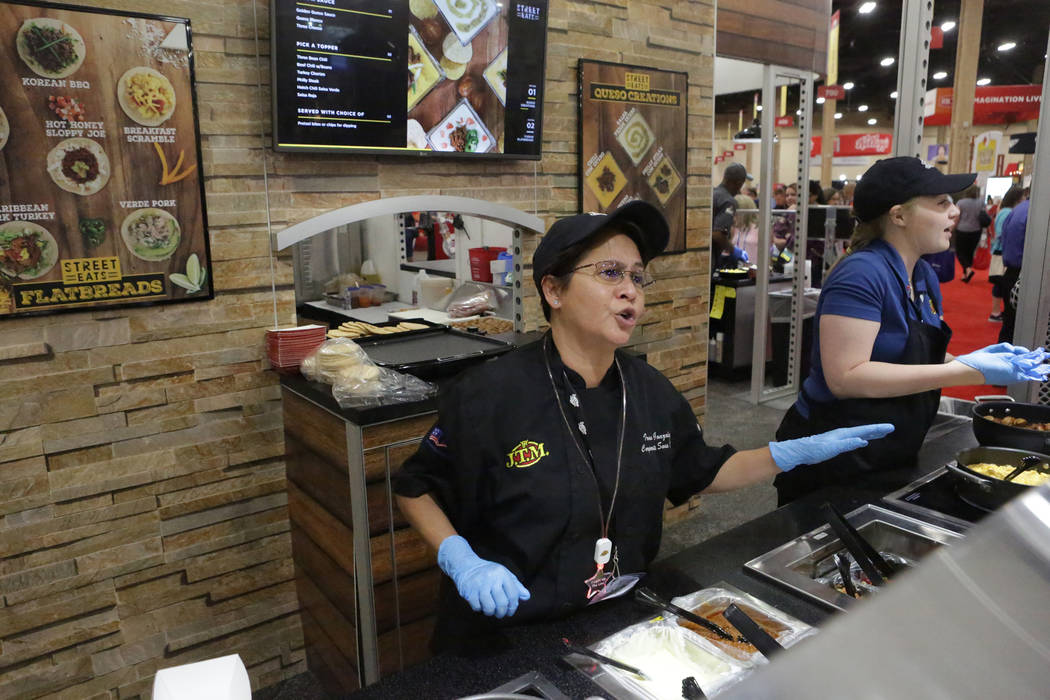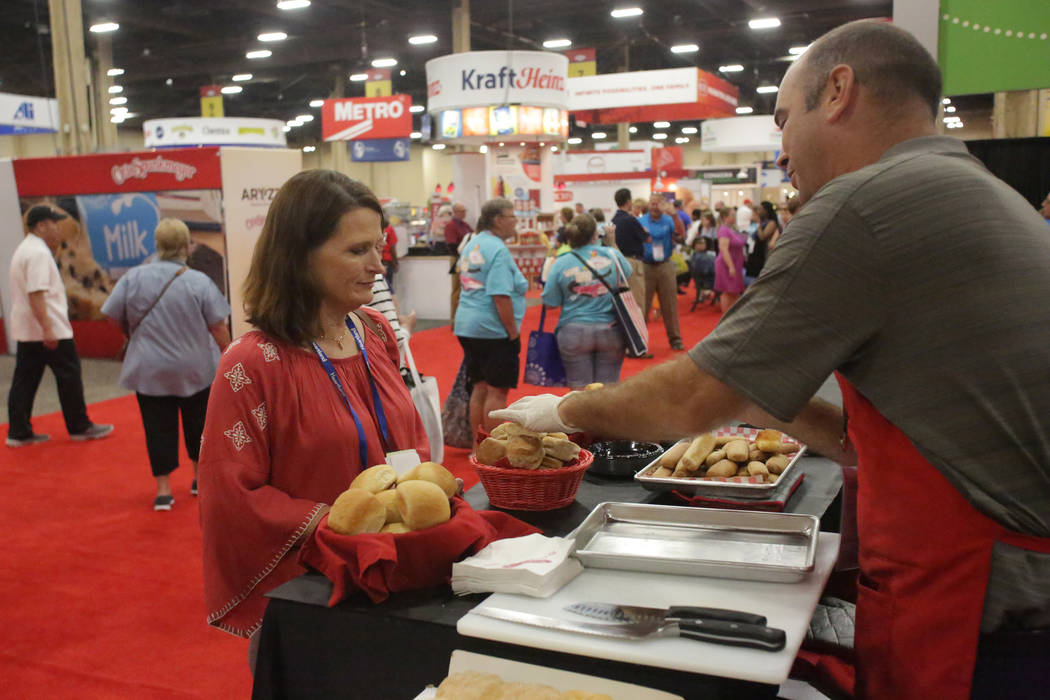School lunches inspire hunt for no-blend smoothies, pea butter






Lory Hayon walked into the Mandalay Bay convention center armed with a “shopping list.”
One of Clark County School District’s dietitians, she and a handful of other members of the department had devised a strategy to divide and conquer the 1,000 vendor tables set up in the exhibit hall as part of the annual School Nutrition Association conference held this past week in Las Vegas.
Hayon was one of more than 57,000 attendees representing some facet of the school food industry at the conference, the association’s largest annual gathering.
School district food and nutrition representatives are constantly playing a balancing game, trying to create interesting and engaging meals for students while meeting federal standards on everything from calories to sodium levels and saturated fats.
On Tuesday, the second day of the conference and the first day the exhibit hall was open, Hayon was on a mission to find blenderless smoothies, a special kind of pea butter and some new types of fruit salsa, among other items.
Blenderless smoothies would save time and labor while also being a quick “grab-and-go” item for kids; the pea protein butter would offer variety for students with allergies; and the fruit salsa was part of an effort to bring more flavor to the district’s lunchrooms.
Hayon sampled one peach mango salsa that she found more eye-catching than your typical red salsa.
“This would really add some dimension to the menu,” she said.
The salsa comes frozen in 6-pound tubs, which is a plus for the district, as it’s the appropriate size for a large school. The district, with more than 320,000 students, can struggle to find vendors that can provide enough product to meet its needs.
National trends
School lunches have changed considerably over the years. Long gone are the days of greasy cheese pizza with a glass of whole milk served as a Friday special or ketchup counting as a vegetable. Now, students are expected to nosh on whole grains, low-fat or fat-free milk and servings of fruits and vegetables at every meal.
The Healthy, Hunger-Free Kids Act of 2010, which was implemented in 2012, set new standards for school cafeterias that have been phased in each year since. In order for schools to get federal reimbursement for cafeteria meals, they must meet the standards.
Some small, wealthy districts or private schools don’t need the reimbursements and can serve outside the regulations, but most districts have been complying for six years now, said Lynn Harvey, president of the School Nutrition Association.
After meeting the standards, districts have turned their attention to trying new ways to add flavor — since there’s a limit on the sodium that can go in each meal — and keeping up with new trends and student expectations.
“It’s not just about meeting a nutrition standard,” Harvey said. “It’s about making sure the food is appealing and enjoyable.”
For example, many families are demanding “clean labels” that provide parents with clear information about what their kids are eating, she said.
There’s also a big push for customization in school cafeterias. Think of a Chipotle-style serving line, where students can pick exactly what goes on their whole-grain tortilla for a burrito.
Searching for bento boxes
Sandy Ford, the chief support services officer for the Manatee County School District in Bradenton, Florida, was tasked by her food and nutrition team to find bento boxes.
“I said, ‘What the heck’s a bento box?’” said Ford, a past president of the association.
For the record, it’s a serving container that originated in Japan and has dividers for different types of food. Traditionally, they hold rice, fish and vegetables, though Ford’s team may have other uses in mind.
Schools face other challenges beyond the dietary updates. Many school cafeterias are working with original equipment from the 1960s or ’70s, said Harvey, who is also the state director for school nutrition services in North Carolina. The equipment often doesn’t meet cooking needs anymore, but many districts are cash-strapped and rightly focused on spending for academic or safety needs, she said.
Time is also a major issue, especially with the rise of customization of meals.
Some school districts may offer only 20 minutes or so for students to eat. That is too short a period for eating, let alone getting a couple of hundred students through a serving line, Harvey said.
That’s where the conference comes in. In addition to the exhibit hall, where vendors show off the latest and greatest, there are panels where officials from around the country share tips and ideas to make a trip to the cafeteria feel like a trip to a restaurant, while still meeting the federal mandates.
“Food is about art,” Harvey said. “In our case, it’s also about science.”
Contact Meghin Delaney at 702-383-0281 or mdelaney@reviewjournal.com. Follow @MeghinDelaney on Twitter.
Related story:
Parents, students to get more info on Clark County school lunches













